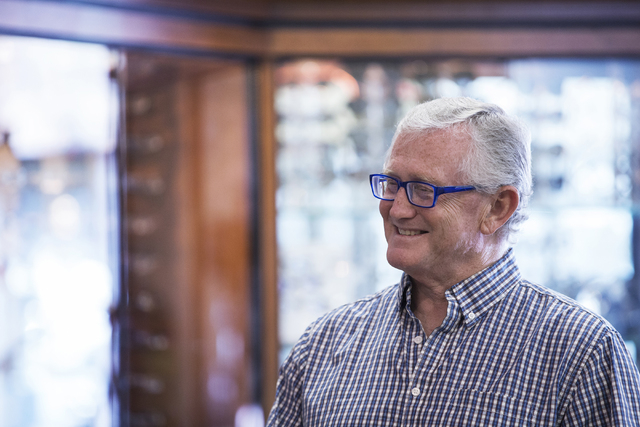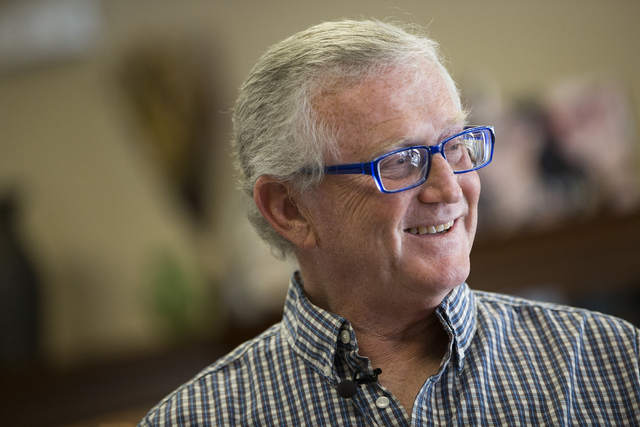Glasses help colorblind people in Las Vegas see the rainbow
At 64 years old, Pastor Dan Winckler had never seen a rainbow.
He had an idea of what he was supposed to see when he ran across pictures of the natural phenomenon, but his vision always fell short.
Seated beside his teenage grandson, Adam Chapel, in the waiting area of Optic Gallery Summerlin on Wednesday, Winckler held a pamphlet adorned with the image of an emerald green field and a rainbow curving upward from the grass.
“There’s a streak of yellow and a streak of blue. That’s what I see,” Winckler said.
“That’s what I see, too,” Chapel piped up.
The grandfather and grandson were two of four colorblind product testers selected to showcase the effects of special glasses manufactured by Berkeley, California-based EnChroma.
Optic Gallery Summerlin, at 7450 W. Lake Mead Blvd., Suite 2, has offered EnChroma glasses for about three months and served as the backdrop for a once-in-a-lifetime experience for the testers. Each tried and took home a pair of the glasses.
The glasses, priced beginning at about $350 for adults, can be made with prescription lenses and filter out certain wavelengths of light that are confusing to photoreceptors in the eyes of colorblind people, optometrist Dr. Wess Jordan said.
“By eliminating some of the wavelengths of light that seem confusing, it makes the other colors seem more robust,” he said.
Jordan and his wife, Dr. Andrea Radtke, run Optic Gallery Summerlin, which is the state’s only authorized EnChroma retail location. EnChroma also sells the glasses online.
The glasses generally have a low chance of success on individuals with blue-green colorblindness, Jordan said.
“Typically a person with a very strong color vision deficiency will mainly see improvement in the color appearance of traffic signals but may not be able to get the ‘super color vision’ experience in the natural world that is reported by persons with less severe impairment,” according to EnChroma’s website.
Outside of the Summerlin shop, facing a shopping center parking lot, the four testers stood, ready to see the world in a whole new way.
Nicholas Lambros Smith, who said he works in costuming for the Cirque du Soleil show “Zarkana,” learned at about age 7 that he couldn’t see colors as everyone else saw them.
He was diagnosed as colorblind when he was a teenager and said mistaking one color for another often embarrassed him.
At work, he said, he had to rely on others to identify the color of a piece of clothing.
“It’s been very difficult because I will grab green when I think it’s yellow, and I will grab orange when it really should be a more red color, and it’s just hard to express what I want to come across not knowing what other people are seeing,” he said.
When the Optic Gallery staff counted down — three, two, one — the four males slid the glasses onto their faces and hoped for the best. Instantly, they all grinned.
Winckler wanted to see the pamphlet again.
“There’s a whole lot more bands than just two, and the field is green, I imagine, not red. I just can’t identify them, but there’s a whole lot more colors,” he said.
Smith described finally seeing what everyone else sees as liberating.
“Everything was a rush of color. It was just so strange because I could see details back in the mountains there that I had never seen before,” he said.
Fellow tester Rob Bailey said he felt he’d had to work harder because of his colorblindness, such as when he trained himself to recognize the colors on a traffic signal.
“It’s like my brain doesn’t have to work as hard at it,” he said. “I love it.”
When Winckler realized the glasses were effective for both him and Chapel, he was thrilled.
“My wife and I like road trips,” he said, “and so I’m eager to drive through some areas, see some wildflowers, maybe see the leaves change colors, and I want to see a rainbow for real.”
Contact Pashtana Usufzy at pusufzy@reviewjournal.com or 702-380-4563. Find her on Twitter: @pashtana_u





























